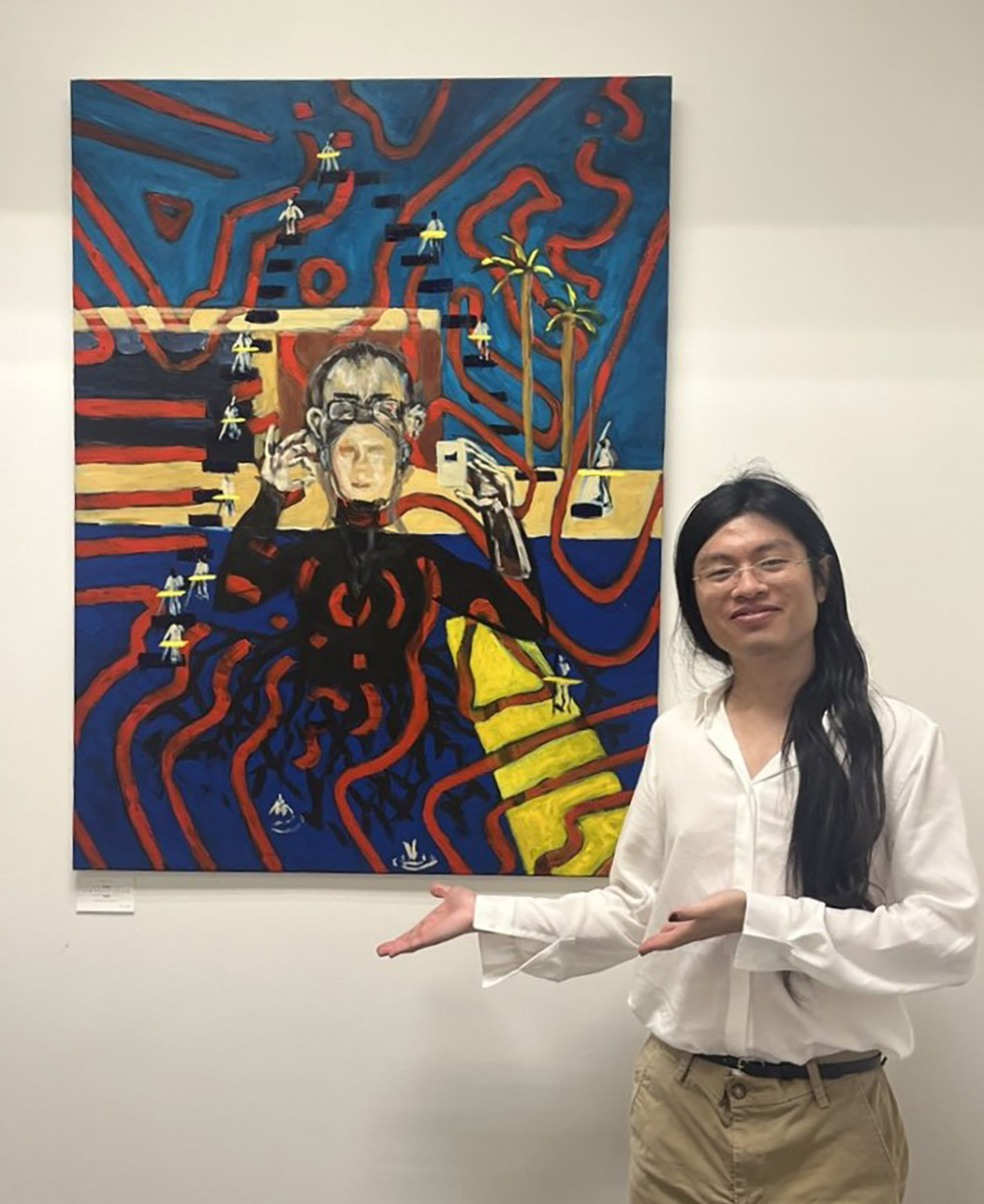For any artist, New York City is not merely a location; it is an active participant in the creative process. Its relentless energy, its gridlock of human stories, and its architectural symphony of glass and brick can either overwhelm or inspire. For painter Lunjia Hu, the city has become a crucible—a place where the internal anxieties of an artist in search of truth have been forged into a powerful and dynamic visual language. In her work, the chaotic pulse of the metropolis and the quiet introspection of the studio merge, creating a compelling dialogue between order and chaos, the cosmic and the mundane.
“When you first arrive, the city feels like a constant state of beautiful, overwhelming noise,” Hu explains, her voice reflecting a thoughtful calm that seems to stand in contrast to the urban energy she describes. “There’s a pressure, not just from the city but from within, to find your place, to understand a grand truth. For a long time, my art was entangled in that search, which was also a source of great anxiety.”
This anxiety, born from the pressures of academic performance and the complexities of navigating a new culture as an international student, became a central theme in her early work. Hu speaks of a “relentless search for a universal truth,” a quest that felt both monumental and deeply ungrounding. This manifested on the canvas as a struggle for control. Her early process was an attempt to tame the unpredictable nature of her materials, to force a pre-conceived order onto a surface that naturally resisted it.
“I believed that to truly capture something, I had to control it completely,” she recalls. “A drip of paint felt like a failure. An unplanned blend of colors was a mistake. I was fighting against the very nature of the medium, and in retrospect, I was fighting against the nature of life itself. New York doesn’t allow for that kind of rigid control. It teaches you, very quickly, that life is a dance with the unpredictable.”
The city became her teacher. By immersing herself in its rhythms, Hu began to see that the dichotomy of order and chaos was not a conflict to be resolved, but a fundamental condition to be embraced. She found it in the rigid grid of Manhattan’s streets, teeming with the unpredictable flow of millions of people, each on their own unscripted journey. She saw it in the meticulously designed façade of a skyscraper, reflecting the chaotic, shifting patterns of the clouds. This realization was a turning point.
“I started to let go,” Hu says. “I began to engage with the local scenery, the values, the people. Instead of looking for a universal truth ‘out there,’ I started looking for the small, tangible truths right in front of me.”
This shift is profoundly evident in her 2024 painting, Handmade Sandwich, Downtown LA. While the subject is from another city, the philosophy behind it was cultivated on the streets of New York. The painting elevates a simple meal from a family-owned café into a subject of fine art. Through warm tones and soft, textured brushstrokes, Hu transforms the mundane into a meditation on craft, care, and the quiet beauty we often overlook. “That sandwich wasn’t just food,” she explains. “It was a moment of pure presence. It was something real and grounding in a world that can feel overwhelmingly abstract. Painting it was an act of honoring the small, perfect moments of order that exist within the larger chaos of life.”
This newfound appreciation for the tangible allowed Hu to shed the constricting weight of what she calls the “stereotyped paths of the foreign identity.” In a city as diverse as New York, identity is fluid and self-defined. The pressure to perform a specific cultural role dissolved in the city’s great melting pot, granting her the freedom to explore more universal human themes.
“New York gives you the anonymity to be truly yourself,” she reflects. “You are no longer just ‘the international artist.’ You are an artist, period. Your story is your own, not one that is projected onto you. This release was liberating. It allowed my work to move from questions of ‘who am I supposed to be?’ to ‘what does it feel like to be human?'”
This question is at the heart of her more abstract and emotionally charged works. In Lost in Joy, two figures are captured in a passionate embrace, their forms nearly dissolving into a swirling vortex of vibrant reds and blues. The piece is a powerful depiction of euphoria, an emotion so overwhelming that it threatens to erase the boundaries of the self. Here, chaos is not a source of anxiety, but of ecstasy. The unrestrained brushstrokes and explosive color palette mirror the internal state of being utterly consumed by a feeling.
At the other end of the spectrum is Primordial Soup Before Life, a monumental abstract work that tackles the very origins of existence. The canvas is a churning, textured landscape of cosmic energy, where circular forms—the building blocks of life—coalesce within a fiery, tumultuous sea.
“With Primordial Soup, I wanted to paint the ultimate state of creative chaos,” Hu says. “It is the moment of pure potential, before any order has been established. It’s a terrifying concept, but also an incredibly hopeful one. It’s the universe as a blank canvas.”
Viewing these three works together—the cosmic abstraction of Primordial Soup, the intimate realism of Handmade Sandwich, and the emotional expressionism of Lost in Joy—one begins to understand the full scope of Hu’s artistic vision. She is an artist who dares to hold the largest and smallest realities in the same frame. For her, the chaotic energy that sparked life in the universe is connected to the overwhelming rush of human joy, which is in turn connected to the quiet, grounding beauty of a carefully made meal.
Living in New York has been the thread that ties these disparate ideas together. It is a city that forces one to confront the immense scale of human existence while simultaneously providing moments of profound, personal connection.
“Every day in this city, you witness the entire spectrum of life,” Hu concludes. “You see grand ambition and quiet struggle, moments of incredible connection between strangers and a profound sense of solitude. You are constantly aware of the vast, chaotic system you are a part of, but you also learn to find and create your own pockets of order, beauty, and meaning. My art is simply a reflection of that process. It is the result of learning to stand in the heart of the chaos and find something true to hold onto.”






